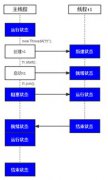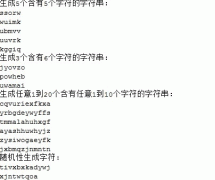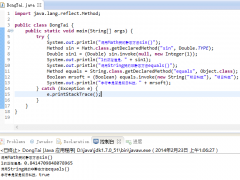Java套接字编程(下)(2)
DatagramSocket类 DatagramSocket类在客户端创建自寻址套接字与服务器端进行通信连接,并发送和接受自寻址套接字。虽然有多个构造函数可供选择,但我发现创建客户端自寻址套接字最便利
DatagramSocket类
DatagramSocket类在客户端创建自寻址套接字与服务器端进行通信连接,并发送和接受自寻址套接字。虽然有多个构造函数可供选择,但我发现创建客户端自寻址套接字最便利的选择是DatagramSocket()函数,而服务器端则是DatagramSocket(int port)函数,假如未能创建自寻址套接字或绑定自寻址套接字到本地端口,那么这两个函数都将抛出一个SocketException对象,一旦程序创建了DatagramSocket对象,那么程序分别调用send(DatagramPacket dgp)和 receive(DatagramPacket dgp)来发送和接收自寻址数据包,
List4显示的DGSClient源代码示范了如何创建自寻址套接字以及如何通过套接字处理发送和接收信息
Listing 4: DGSClient.Java
// DGSClient.java
import java.io.*;
import java.net.*;
class DGSClient
{
public static void main (String [] args)
{
String host = "localhost";
// If user specifies a command-line argument, that argument
// represents the host name.
if (args.length == 1)
host = args [0];
DatagramSocket s = null;
try
{
// Create a datagram socket bound to an arbitrary port.
s = new DatagramSocket ();
// Create a byte array that will hold the data portion of a
// datagram packet's message. That message originates as a
// String object, which gets converted to a sequence of
// bytes when String's getBytes() method is called. The
// conversion uses the platform's default character set.
byte [] buffer;
buffer = new String ("Send me a datagram").getBytes ();
// Convert the name of the host to an InetAddress object.
// That object contains the IP address of the host and is
// used by DatagramPacket.
InetAddress ia = InetAddress.getByName (host);
// Create a DatagramPacket object that encapsulates a
// reference to the byte array and destination address
// information. The destination address consists of the
// host's IP address (as stored in the InetAddress object)
// and port number 10000 -- the port on which the server
// program listens.
DatagramPacket dgp = new DatagramPacket (buffer,
buffer.length,
ia,
10000);
// Send the datagram packet over the socket.
s.send (dgp);
// Create a byte array to hold the response from the server.
// program.
byte [] buffer2 = new byte [100];
// Create a DatagramPacket object that specifies a buffer
// to hold the server program's response, the IP address of
// the server program's computer, and port number 10000.
dgp = new DatagramPacket (buffer2,
buffer.length,
ia,
10000);
- 上一篇:java简单数据类型
- 下一篇:Java套接字编程(下)(3)
精彩图集
精彩文章





